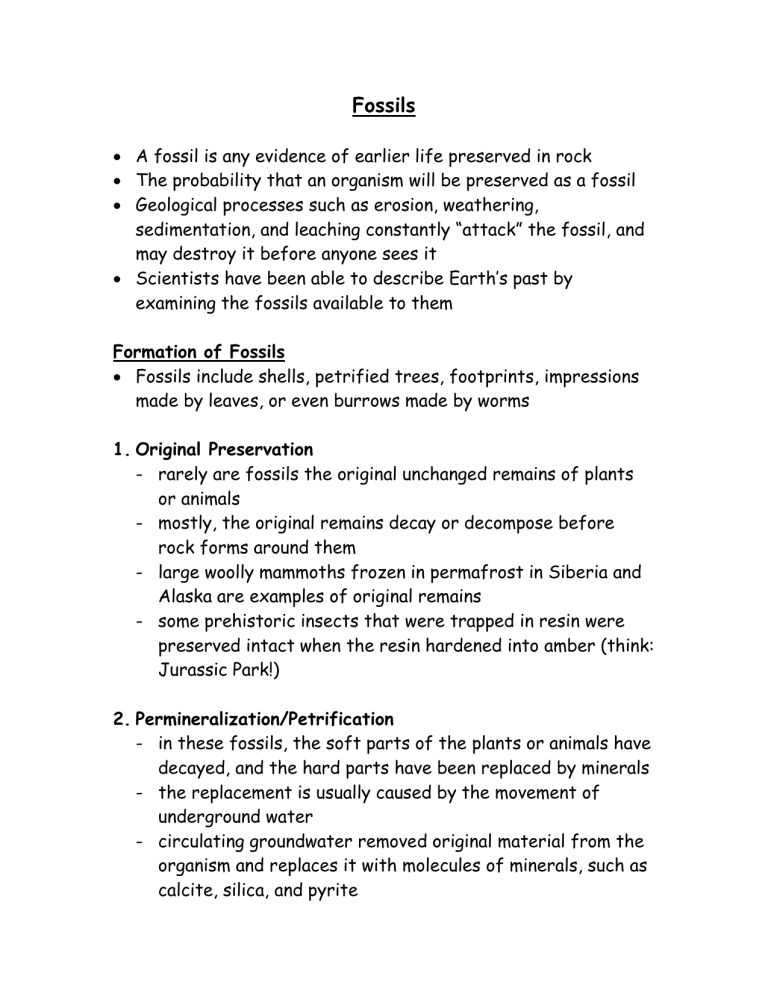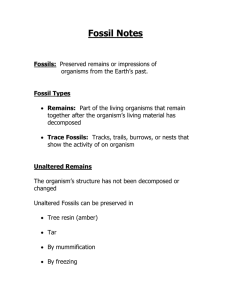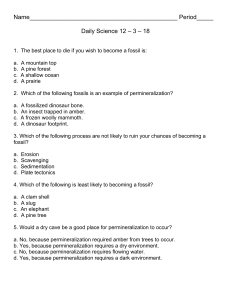Fossils

Fossils
A fossil is any evidence of earlier life preserved in rock
The probability that an organism will be preserved as a fossil
Geological processes such as erosion, weathering, sedimentation, and leaching constantly “attack” the fossil, and may destroy it before anyone sees it
Scientists have been able to describe Earth’s past by examining the fossils available to them
Formation of Fossils
Fossils include shells, petrified trees, footprints, impressions made by leaves, or even burrows made by worms
1.
Original Preservation
rarely are fossils the original unchanged remains of plants or animals
mostly, the original remains decay or decompose before rock forms around them
large woolly mammoths frozen in permafrost in Siberia and
Alaska are examples of original remains
some prehistoric insects that were trapped in resin were preserved intact when the resin hardened into amber (think:
Jurassic Park!)
2.
Permineralization/Petrification
in these fossils, the soft parts of the plants or animals have decayed, and the hard parts have been replaced by minerals
the replacement is usually caused by the movement of underground water
circulating groundwater removed original material from the organism and replaces it with molecules of minerals, such as calcite, silica, and pyrite
the result is an exact copy of the original plant or animal
permineralization is different from petrification in that the organic material is only filled with minerals and not completely replaced
permineralization is the first step in petrification. In petrification, the cellulose cell walls are completely replaced by minerals
most dinosaur bones are permineralized
3.
Mold and Cast Formations
after an organism is buried in mud or other sediments, its hard body parts become a fossil as sediments become rock
if the fossil later dissolves out of the rock, a hollow depression in the rock, called a mold results
the mold show the original shape and surface of the fossil
mineral may then seep into the mold and fill it, forming a
cast, a copy, of the original fossil
mold and casts of shellfish are common fossils
4.
Carbonization
sometimes the only fossil trace is a thin carbon film resembling a silhouette
the remains of plant or animals in sediments are affected by high temperature and pressure as additional sediments are deposited
these conditions cause the carbon compounds that make up the tissues of animals and plants to undergo chemical changes
nitrogen, hydrogen, and oxygen are driven off as gases leaving an outline of the organism


![F3-4 Study Guide for QUIZ [1/28/2016]](http://s3.studylib.net/store/data/006814899_1-56a576b1a51c0f876f28a8da0f15de89-300x300.png)




